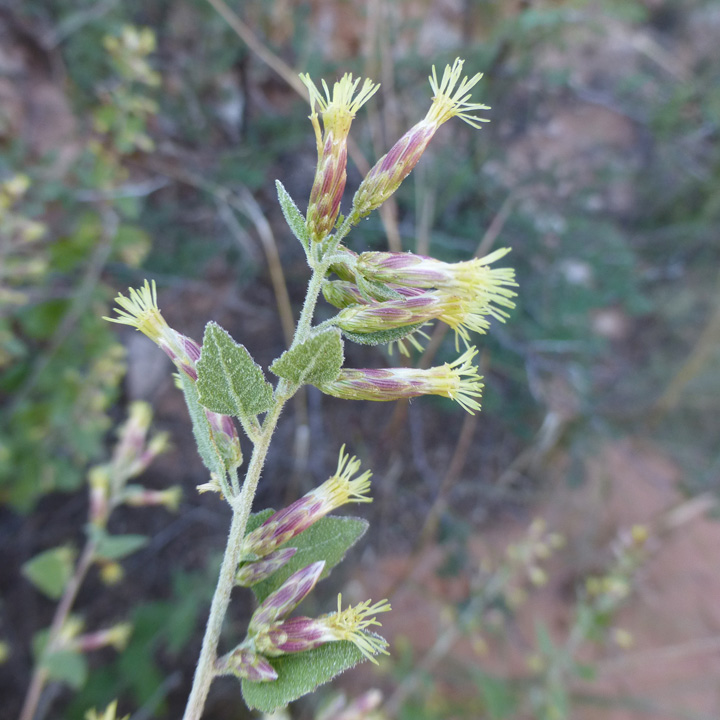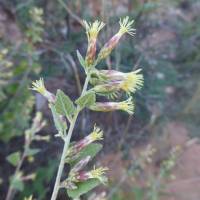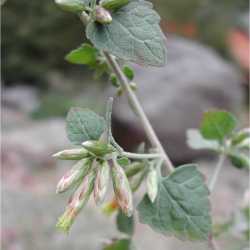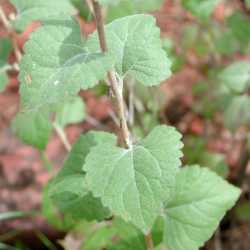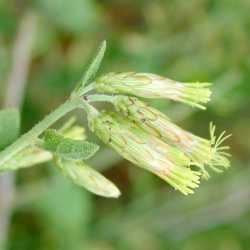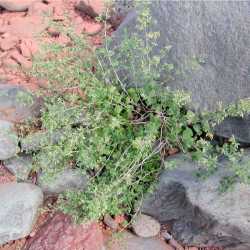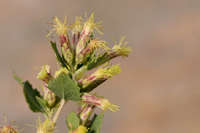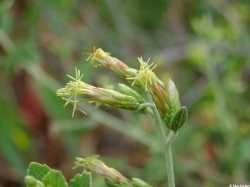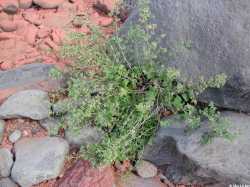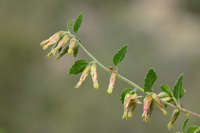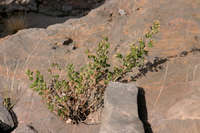Shrubs, 50-200 cm. Stems branched from near bases, glandular-pubescent. Leaves alternate; petioles 5-60+ mm; blades 3-nerved from bases, ovate to deltate, 10-100 × 10-90 mm, bases cordate to truncate, margins crenate to serrate, apices acute to rounded, faces puberulent to glabrate, often gland-dotted. Heads borne in (leafy) paniculiform arrays. Peduncles 1-5 mm, glandular-pubescent. Involucres cylindric to obconic, 7-12 mm. Phyllaries 21-35 in 5-6 series, greenish, often purple-tinged, 3-4-striate, unequal, margins scarious; outer ovate to lance-ovate (glabrous or sparsely glandular-pubescent, apices acute to acuminate), inner lanceolate (glabrous, apices obtuse to acuminate). Florets 8-12; corollas pale yellow-green, 5.5-8 mm. Cypselae 2.5-3.5 mm, puberulent; pappi of 24-30 white, barbellate bristles. 2n = 18.
Flowering Jul-Oct. Dry, rocky hillsides, arroyos, canyons; 800-2700 m; Ariz., Calif., Colo., Idaho, Nev., N.Mex., Okla., Tex., Utah, Wyo.
Floret number of 18 is reported for Brickellia californica in most floras; A. Cronquist (1994) noted that 18 is high by his count; he reported 12 as the maximum number for the specimens he sampled and that fits the specimens I have counted from Arizona.
Common Name: California brickellbush
Duration: Perennial
Nativity: Native
Lifeform: Subshrub
Wetland Status: FACU
General: Intricately branched shrub, 50-200 cm tall; stems woody at the base and often well above the base, glandular-pubcescent; branches ascending, whitish below and purplish, brownish, or grayish above.
Leaves: Alternate, on petioles 5-60 mm long; blades 3-nerved from base, deltate to ovate, 1-10 cm long by by 1-9 cm wide, with irregularly dentate or crenate-serrate margins; the faces puberulent to glabrate and often gland dotted.
Flowers: Flower heads discoid, arranged in dense panicles or solitary in axils, on short peduncles, these 1-5 mm long; involucre (ring of bracts wrapped around flower head) cylindric to obconic, 7-12 mm high, the bracts (phyllaries) 21-35 in 5-6 series, unequal, greenish stramineous to purple-tinged with scarious margins, subacute to rounded at tips; florets 8-12, all discs, the corollas greenish white, often tinged with purple, 5-8 mm long.
Fruits: Achenes puberulent, 3 mm long, topped with a pappus of 24-30 white, barbellate bristles.
Ecology: Found on dry rocky hillsides, in arroyos and canyons, from 2,500-9,000 ft (762-2743 m); flowers July-October.
Distribution: Much of western N. Amer. from OR east to WY and south to CA, AZ, NM, and TX; south to s MEX.
Notes: Brickellia is a genus of shrubs and perennial herbs with all disc flowers, these usually white to cream colored; flower heads wrapped in several rows of bracts (phyllaries), the outer rows shorter than the inner rows; and 10-nerved seeds topped with white tufts of bristles. B. californica is one of the more common shrubby Brickellia found in the region, distinguished by the small diamond- to heart-shaped leaves, < 5 cm long, with toothed edges; on slender stems that are often woody well above the base of the plant; flower heads clustered on short peduncles toward the ends of branches, forming drooping spike-like panicles; and glabrous phyllaries. B. baccharidea is similar but in that species the leaves have cuneate (tapering) bases and the peduncles are longer, > 5 mm; also similar to B. coulteri but that species has opposite leaves with enlarged sharp basal lobes at the base (hastate lobes).
Ethnobotany: Used ceremonially; as a lotion for sores; for cough and fever; as a rub for headaches; and as a tea.
Etymology: Brickellia is named for Dr. John Brickell (1749-1809), a botanist and physician who worked in Georgia; californica means of or from California.
Synonyms: Bulbostylis californica, Brickellia brandegei
Editor: SBuckley 2010, FSCoburn 2015, AHazelton 2015


